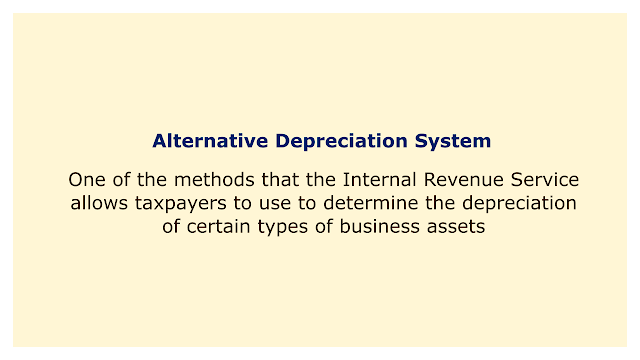 |
| Image: Moneybestpal.com |
Alternative Depreciation System (ADS) is one of the methods that the Internal Revenue Service (IRS) allows taxpayers to use to determine the depreciation of certain types of business assets.
Depreciation is an accounting technique that enables companies to spread out the cost of an asset over the expected useful life, which is the anticipated number of years the equipment will be used to help the firm earn income.
Compared to another approach called the General Depreciation System (GDS), which employs a decreasing balance method, the ADS method calculates depreciation using a straight-line method over a longer period of time. According to the straight-line technique, every year's depreciation is set at the same amount, with the exception of the beginning and end years, which are often lower because they do not contain a full year. The depreciation rate is applied to the non-depreciated amount when using the declining balance approach, which causes a higher depreciation expense in the early years and a reduced depreciation expense in the later years.
The benefit of employing ADS is that it lowers the annual depreciation expense, which can cut the taxable income and postpone taxes. The drawback is that it lengthens the period of time over which the asset may be written off, which means that the cost of the asset must be recovered over a longer period of time.
ADS is required by the IRS for certain types of assets in special circumstances, such as:
Additionally, taxpayers have the option to employ ADS for any class of property for any tax year, but they are required to do so for all of the same-class property that is put into operation during that year. After ADS has been selected, GDS cannot be changed back. Taxpayers must use Form 4562 - Depreciation and Amortization, which enables them to choose which system to employ, to elect ADS.
For both the GDS and ADS approaches, the IRS publishes tables for various asset types and recovery times. For instance, a 5-year property class under GDS has a recovery duration of 5 years and a first-year depreciation rate of 20%, whereas, under ADS, it has a recovery period of 12 years and a first-year depreciation rate of 8.33%, according to IRS Publication 946. Under GDS, a 7-year property class has a recovery period of 7 years and a first-year depreciation rate of 14.29%; however, under ADS, the recovery period is 25 years and the first-year depreciation rate is 4%.
Let's imagine that a business purchases a computer for $10,000 in January 2020 and uses it for professional reasons to demonstrate how ADS functions. The computer falls within the five-year property category. The following table can be used to depreciate the computer if the business uses GDS:
If the company uses ADS, it can depreciate the computer using the following table:
As you can see, using ADS results in a lower depreciation expense each year, but also a longer recovery period for the asset.
Compared to another approach called the General Depreciation System (GDS), which employs a decreasing balance method, the ADS method calculates depreciation using a straight-line method over a longer period of time. According to the straight-line technique, every year's depreciation is set at the same amount, with the exception of the beginning and end years, which are often lower because they do not contain a full year. The depreciation rate is applied to the non-depreciated amount when using the declining balance approach, which causes a higher depreciation expense in the early years and a reduced depreciation expense in the later years.
The benefit of employing ADS is that it lowers the annual depreciation expense, which can cut the taxable income and postpone taxes. The drawback is that it lengthens the period of time over which the asset may be written off, which means that the cost of the asset must be recovered over a longer period of time.
ADS is required by the IRS for certain types of assets in special circumstances, such as:
- Assets used predominantly outside the United States
- Tax-exempt use of property
- Tax-exempt bond-financed property
- Farm property
- Listed property used 50% or less in a qualified business use
- Indian reservation property
Additionally, taxpayers have the option to employ ADS for any class of property for any tax year, but they are required to do so for all of the same-class property that is put into operation during that year. After ADS has been selected, GDS cannot be changed back. Taxpayers must use Form 4562 - Depreciation and Amortization, which enables them to choose which system to employ, to elect ADS.
For both the GDS and ADS approaches, the IRS publishes tables for various asset types and recovery times. For instance, a 5-year property class under GDS has a recovery duration of 5 years and a first-year depreciation rate of 20%, whereas, under ADS, it has a recovery period of 12 years and a first-year depreciation rate of 8.33%, according to IRS Publication 946. Under GDS, a 7-year property class has a recovery period of 7 years and a first-year depreciation rate of 14.29%; however, under ADS, the recovery period is 25 years and the first-year depreciation rate is 4%.
Let's imagine that a business purchases a computer for $10,000 in January 2020 and uses it for professional reasons to demonstrate how ADS functions. The computer falls within the five-year property category. The following table can be used to depreciate the computer if the business uses GDS:
 |
| Image: Moneybestpal.com |
 |
| Image: Moneybestpal.com |
